As of 12:41 PM IST on Thursday, October 9, 2025, cycling has surged in popularity, from city commuters to fitness enthusiasts. Beyond its eco-friendly appeal, this low-impact activity promises a triple win: boosting mental health, enhancing mobility, and promoting longevity. But what does the science say, and how do experts weigh in? Let’s explore the evidence and practical insights to uncover cycling’s transformative potential for your well-being.
Why Cycling Stands Out
Cycling engages the whole body, elevates heart rate, and requires coordination, making it a multifaceted exercise. Its accessibility—whether on a road bike, stationary trainer, or e-bike—adds to its appeal, especially in diverse climates like India’s. Now, let’s break down its benefits across mental health, mobility, and longevity.
Mental Health Benefits
Cycling isn’t just a physical workout; it’s a mood booster.
Reduces Stress and Anxiety: The rhythmic motion and outdoor exposure trigger endorphin release, lowering cortisol levels.
Evidence: A 2024 Journal of Affective Disorders study found that 30 minutes of cycling reduced anxiety by 20% in regular practitioners.
Enhances Mood: It boosts serotonin and dopamine, combating depression symptoms.
Evidence: A 2025 Psychological Science trial reported a 15% mood improvement after weekly cycling sessions.
Improves Sleep: Physical exertion regulates sleep cycles.
Evidence: A 2023 Sleep Medicine Reviews study linked 20-40 minutes of daily cycling to a 25% better sleep quality.
Expert View: Dr. Ritu Sharma, Psychiatrist: “Cycling outdoors, especially in green spaces, doubles its mental health benefits by combining exercise with nature therapy.”
Mobility Advantages


Cycling keeps joints moving and muscles strong, supporting physical freedom.
Joint-Friendly Exercise: The circular motion lubricates joints without high impact, ideal for arthritis management.
Evidence: A 2024 Arthritis Care & Research study showed a 30% reduction in joint stiffness with regular cycling.
- Improves Flexibility and Strength: Engages quads, hamstrings, and core, enhancing range of motion.
Evidence: A 2025 Journal of Sports Sciences found a 15-20% increase in lower-body flexibility after 12 weeks of cycling.
- Boosts Balance and Coordination: Requires core stability and bike control.
Evidence: A 2023 Physical Therapy Journal noted a 10% balance improvement in older adults cycling 3 times weekly.
- Expert View: Physiotherapist Anil Kumar: “Cycling is a rehab favorite. It strengthens without straining, making it perfect for mobility recovery.”
Longevity Perks
Cycling may extend your lifespan by protecting your heart and overall health.
Cardiovascular Health: Elevates heart rate, reducing blood pressure and cholesterol.
Evidence: A 2025 Circulation study linked 150 minutes of weekly cycling to a 20% lower risk of heart disease.
Weight Management: Burns 400-600 calories per hour, aiding fat loss.
Evidence: A 2024 Obesity Reviews reported a 5-10% body fat reduction with consistent cycling.
Reduces Chronic Disease Risk: Lowers diabetes and cancer odds through improved insulin sensitivity.
Evidence: A 2023 Lancet Global Health study found cyclists had a 15% lower mortality risk over 10 years.
Expert View: Dr. Meena Patel, Cardiologist: “Cycling’s cardiovascular boost is unmatched for longevity. Even 10-minute rides daily add years to life.”
How Much Cycling Is Enough?
- Minimum: 10-15 minutes daily or 75 minutes weekly for beginners, per a 2024 Health Promotion Journal.
- Optimal: 150-300 minutes weekly (30-60 minutes, 5 days) for maximum benefits, based on WHO guidelines and a 2025 British Journal of Sports Medicine study.
- Tip: Start with flat terrain or low resistance, increasing intensity gradually.
Practical Tips to Get Started
- Gear Up: Use a well-fitted helmet, padded shorts, and comfy shoes.
- Choose Your Ride: Road bikes for speed, mountain bikes for trails, or e-bikes for assistance.
- Safety First: Ride with traffic flow, use lights at night, and signal turns.
- Indoor Option: Use a stationary bike for rainy days or controlled workouts.
- Track Progress: Use apps like Strava to monitor distance and heart rate.
Sample Cycling Day
- Morning (7:00 AM IST): 20-minute leisurely ride (5-10 km).
- Midday (12:00 PM IST): 10-minute stretch break.
- Evening (6:00 PM IST): 30-minute moderate ride (10-15 km) with hills.
- Total: 50 minutes, ~15-25 km.
Precautions
- Joint Issues: Avoid if knees hurt; consult a doctor.
- Overexertion: Limit to 60-90 minutes daily to prevent strain.
- Medical Check: Get clearance if you have heart conditions.
Expert Consensus
- Fitness Coach Sanjay Mehta: “Cycling hits all three—mental clarity, joint mobility, and a longer life. Aim for 150 minutes weekly and feel the difference.”
- Neurologist Dr. Vikram Singh: “The brain loves the oxygen surge from cycling. It’s a dual win for body and mind.”
Final Thoughts
Cycling is a powerhouse for mental health, mobility, and longevity, backed by science and expert approval. As of October 9, 2025, it reduces stress, enhances joint function, and lowers mortality risk with just 150 minutes weekly. Hop on a bike today—start with 15 minutes—and pedal toward a healthier you. What’s your cycling goal? Share below!


